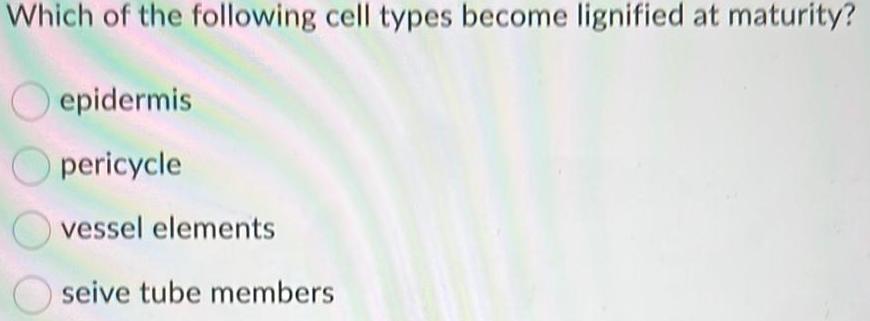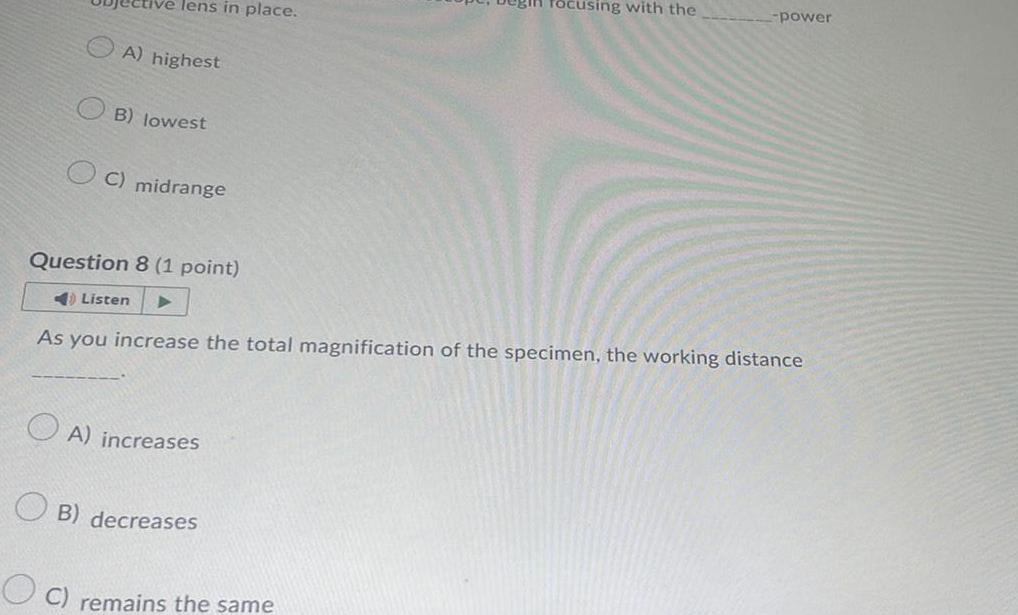Anatomy of Flowering Plants Questions and Answers

Biology
Anatomy of Flowering PlantsQuestion 24 1 po One day you go outside and see that the cars on the street are dust Which of the following statements can be correctly applied to this dust OAI The dust is the spore production of ferns and is so abundant because the spores are wind dispersed OB The dust is pine pollen and is so abundant because the pines are wind pollinated Og The dust is the seed production of pines and is so abundant because the seeds are tiny and take very little energy to produce D The dust is the seed production of ferns and is so abundant because the seeds are tiny and take very little energy to produce

Biology
Anatomy of Flowering PlantsListen The presence of vascular tissue allowed plants to O Al absorb nutrients from the soil and form a symbiosis with fungi OB transport nutrients and water from below ground tissues to above ground tissues and grow taller Og release toxins into the soll that reduced competition with other plants by poisoning nearby plants o transport nutrients and water from below ground tissues and use them to protect developing embryos D

Biology
Anatomy of Flowering PlantsWhich of the following statements about stomata O A Stomata are not important in algae because they do not need CO2 OBI Stomata are important in terrestrial plants because they allow the roots to absorb water and nutrients from the soil OC Stomata when closed allow CO2 to diffuse into plants D Stomata are important in terrestrial plants because they allow CO2 to diffuse into the plant

Biology
Anatomy of Flowering PlantsFood OUde M Savalli A typhlosole B intestine C gizzard DEE D E F G H I J K seminal vesicles seminal receptacle prostomium hearts pharynx calciferous gland nephridium select answer th J K 00000 intestine nephridium pharynx seminal receptacle hearts calciferous gland gizzard E

Biology
Anatomy of Flowering Plantshelps to prevent excessive water loss through the skin Glycolipids secreted by keratinocytes into extracellular spaces The size and shape of the cells that make up the stratum spinosum as well as the thick bundles of intermediate filaments The thickness of the dermis which prevents water from passing through it Fat associated with skin prevents water loss Question 35 2 points Listen Match the cells found in the epidermis with their description Cells that produce melanin located in the deepest layer of the epidermis Macrophages that ingest foreign molecules and are key activators of the immune system The predominant cell type in the epidermis produce the fibrous protein keratin Sensory touch receptors 1 Dendritic cells 2 Keratinocytes 3 Melanocytes 4 Tactile cells

Biology
Anatomy of Flowering Plantsbone deposit and resorption rickets Paget s disease osteoporosis osteomalacia Question 20 2 points Listen order characterized by excessive and haphazard Match the type of epithelia with its description Multiple layers of cells with a basal layer of cuboidal or columnar cells and apical cells that vary in appearance depending on the degree of stretch in the organ Multiple layers of cells but only the apical layer is columnar A single layer of cells that vary in height making it appear to be multiple layers A single layer of cells that 1 Pseudostratified columnar epithelium 2 Simple columnar epithelium 3 Stratified columnar epithelium 4 Transitional epithelium

Biology
Anatomy of Flowering PlantsTreatment for severe burns includes which of the following Select ALL that apply Supplementary nutrients through gastric tubes and IV lines Replacement of lost fluid through IV Antibiotics Debridement of the burned skin

Biology
Anatomy of Flowering PlantsWhich of the following is NOT a protein structure type A Secondary B Tertiary C Elementary D Primary

Biology
Anatomy of Flowering PlantsThe image below is a cross section of a n monocot root dicot root monocot stem dicat stom

Biology
Anatomy of Flowering PlantsWhich of the following cell types become lignified at maturity epidermis pericycle vessel elements seive tube members

Biology
Anatomy of Flowering PlantsWhich of the following lines of Shakespeare s Sonnet 18 has reverse word order A Shall I compare thee to a Summer s day B Sometime too hot the eye of heaven shines C So long as men can breathe or eyes can see D Thou art more lovely and more temperate Shall I Compare Thee to a Summer s Day Sonnet 18 by William Shakespeare 1 Shall I compare thee to a Summer s day Thou art more lovely and more temperate winds do chake the darling buds of May

Biology
Anatomy of Flowering PlantsHow is Baldwin s adaptation different from Ovid s original text O In Baldwin s adaptation the flood spreads over the Earth more completely while in Ovid s original the flood covers a small area In Baldwin s adaptation the flood comes from Jupiter and is more violent while in Ovid s original the flood is naturally occurring and gentler O In Baldwin s adaptation the flood covers every part of the Earth more quickly while in Ovid s original it takes a long time to flood the whole world In Baldwin s adaptation the flood is caused by Jupiter alone while in Ovid s original it is caused by a group of gods

Biology
Anatomy of Flowering PlantsThe plastic molten layer that the tectonic plates float upon is called the A asthenosphere C lithosphere B crust D mantle

Biology
Anatomy of Flowering PlantsPrimary succession is a form of ecological succession in which life takes hold in a n

Biology
Anatomy of Flowering Plantsstrial To study energy dynamics in a ter ecosystem one could measure the change in mass of brussel sprouts and caterpillar larvae a controlled environment The system will ecome unsustainable if the larvae continue to and the brussel sprouts don t grow lose mass B gain mass C have a negative NPP

Biology
Anatomy of Flowering PlantsWhich of the following is present within a known biosphere A mantle of the earth C ionosphere B arctic tundra D deep space

Biology
Anatomy of Flowering Plantshy did Austria Hungary dedare war on Serbia Austria Hungary was determinted to have a war against Serbia regardless Serbia met their demands Serbia didn t own up about its participation in the killing of the Archduke Francis Ferdinand O Serbia tried to ally with Russia for protection All of the choices

Biology
Anatomy of Flowering PlantsWhat property of radioisotopes makes them valuable tools for biological research and medicine They have much more mass than their corresponding atom The radioactivity produced when they spontaneously decay into more stable forms can be detected with scanners They are not useful for either biological research or medicine because they damage living tissue They are structural variations of atoms that differ in the number of neutrons

Biology
Anatomy of Flowering PlantsBehavior in response to working with others is as the interaction provides an evolutionary advantage A habituation B socialization C classical conditioning D proximal conditioning

Biology
Anatomy of Flowering PlantsWhich of the following is NOT a part of the leg of the grasshopper a Coxa b Tarsus c Trochanter d Femur e Tympanum

Biology
Anatomy of Flowering PlantsUltimately our behaviors are linked to gaining a n over others in a similar environment A evolutionary advantage B altruistic edge C social advantage D dominant advantage

Biology
Anatomy of Flowering PlantsQuestion 3 1 point To what phylum does the organism shown here belong

Biology
Anatomy of Flowering PlantsType of Bryophyte Native or Invasive Other counties it has been seen in Common Name Insert a picture you may download from the internet provide image source Any interesting information you may have learned about the plant food source toxic aquatic or anything you thought was interesting Native Tree Moss Name Rosul yum capillare Native Capillary thread moss

Biology
Anatomy of Flowering Plantslens in place A highest B lowest C midrange Question 8 1 point Listen A increases As you increase the total magnification of the specimen the working distance B decreases focusing with the C remains the same power

Biology
Anatomy of Flowering Plants5 What type of wrench joins finely finished nickel plated or polished brass pipes without scratching their finished surfaces A Strap OB Crown C C Stillison OD Spud

Biology
Anatomy of Flowering Plants11 Oakum would be most often used when joining OA glass pipe OB hubbed cast iron pipe OC plastic pipe D hubless cast iron pipe

Biology
Anatomy of Flowering Plants6 You can adjust the jaws of a monkey wrench to grip A oily fittings in flush tanks B odd sized nuts and fittings OC small nickel plated pipes OD polished brass pipes

Biology
Anatomy of Flowering Plants8 What would you use to prevent a grooving tool from overheating OA An approved pipe joint compound OB A higher rpm setting O C Cutter wheels instead of roller wheels O D Cutting oil

Biology
Anatomy of Flowering PlantsHigh fructose corn syrup HFCS normally has approximately what composition more than mannose dextrose glucose fructose Ofructose mannose dextrose mannose None of these options is correct fructose glucose Question 63 1 point The French Paradox refers to None of these options is correct the low liver cancer rate despite high wine consumption in France the unusually high incidence of heart disease despite low average cholesterol levels the preference to carry baguettes under the arm O an unusually low incidence of heart disease despite high fat consumption quic movies

Biology
Anatomy of Flowering PlantsWhat differentiates xylem tissue from phloem tissue 2 of 4 QUESTIONS Oxylem transports sugars produced in plant leaves phloem does not Xylem is made up of sclerenchyma tissue phloem is made up of parenchyma tissue Oxylem has a one way flow phloem has a two way flow Oxylem transports only water phloem transports minerals

Biology
Anatomy of Flowering PlantsTall grasses have stems that must be rigid yet able to bend in the wind without breaking Which of these is most likely to describe the tissue in these stems O Ground tissue made of parenchyma cells Vascular tissue made of parenchyma cells Ground tissue made of collenchyma cells O Meristematic tissue made of collenchyma cells 3 of 8 QUESTIONS SULMIT

Biology
Anatomy of Flowering PlantsWas forming distinct groups easier or more difficult than you expected Explain What other information would you have liked to have about the animals in order to make your decisions

Biology
Anatomy of Flowering PlantsV Angiosperms 4 TE 15 Gymnosperms O chlorophyll O waxy cuticle U S O stomata pores O true leaves 3 Ferns 2 at Mosses Q in the above tree represents the evolution of O waxy cuticle AND stomata pores O all of the answer choices R 1 P Charophytes

Biology
Anatomy of Flowering PlantsQuestion 7 Match the following letter with the correct term B C D BA D Choose1 metaphioem tracheid vascular cambium parenchyma vessel element protoxylem vascular meristem metaxylem sclerenchymia Choose

Biology
Anatomy of Flowering PlantsAnswer the following questions by filling in the blank with the correct letter A B C D Which of the following root zones would contain the root apical meristem Zone Which of the following root zones would be associated with root hairs for absorption Zone

Biology
Anatomy of Flowering PlantsThe rip off a part of the MHC and places the antigen on new antibodies to boost immunity A helper T cells B MHC C large T cells D B cells

Biology
Anatomy of Flowering PlantsThose with Type O blood are universal donors but cannot receive any other blood type because they have antibodies A no B only anti A C only anti B D anti A and anti B

Biology
Anatomy of Flowering PlantsThe project for the pharma students was to identify a drug The role of this drug is to prevent the virus from recognizing a protein on the animal cell membrane host As soon as the virus binds to the host membrane protein the viral membrane and host cell membrane fuse This helps the virus to inject its genome into the host Which component of the virus should the drug block O matrix protein tall fibers Ospike None of these

Biology
Anatomy of Flowering Plantsre your thoughts on how you can synergies your savings by making sure your money is working for you not against yo

Biology
Anatomy of Flowering PlantsAll of the following were injustices perpetrated against Asian immigrants once they reached th mainland EXCEPT O They could not own property They were heavily taxed They were forced to change their names

Biology
Anatomy of Flowering PlantsWhich structure is highlighted O acinar tissue O duct O basement membrane O pancreatic islet

Biology
Anatomy of Flowering PlantsWhich of the following is not accepted by historians as a factor that contributed greatly to the modernization of the U S O Aggressive support by the federal government O A high level of literacy O An openness to change Yankee Ingenuity

Biology
Anatomy of Flowering PlantsMiddle and Upper Class Women During the 19th Century Industrial Revolution Often worked for charities or became activists Pushed for social reforms such as labor reforms and gender equality If historians were to use this information to gain a better understanding of I in the 19th century for women what would they be doing A Differentiating the lives of middle and upper class women durin the Industrial Revolution OB Determining how successful 19th century women were at achieving their goals C Contextualizing the experiences of women during the Industrial Revolution O D Classifying the quality of life for men and women during the Industrial Revolution

Biology
Anatomy of Flowering Plantsresource is replaced at a constant rate regardless of how much is used it is considered to be A B non depletable non sustainable Il

Biology
Anatomy of Flowering PlantsThe conversion of NADH to NAD is often coupled with the conversion of O ADP to ATP methanol to formaldehyde ethanol to acetaldehyde O ATP to ADP

Biology
Anatomy of Flowering PlantsWhat is the days supply for this prescription Alprazolam 0 5mg tablets Disp 100 tabs Sig 1 tab TID VID 3 100 30 days 33 days 50 days 25 days

Biology
Anatomy of Flowering PlantsWater will to the xylem and connect to other water molecules by cohesion to facilitate transpiration A adhere B hydrogen bond C lock and key latch on

Biology
Anatomy of Flowering PlantsA Plants can respond to sunlight by bending towards sunlight in a process called reflex arc B gravi tropism C photo tropism

Biology
Anatomy of Flowering PlantsMatch each type of fossil to its description trace fossil petrified fossil mold cast carbon film living thing turned to rock record of an organism s activity solid copy hollow form detail left after an organism decays

Biology
Anatomy of Flowering PlantsThe unique reproductive method plants go through is called A budding B fragmentation C alternation of generations D conjugation